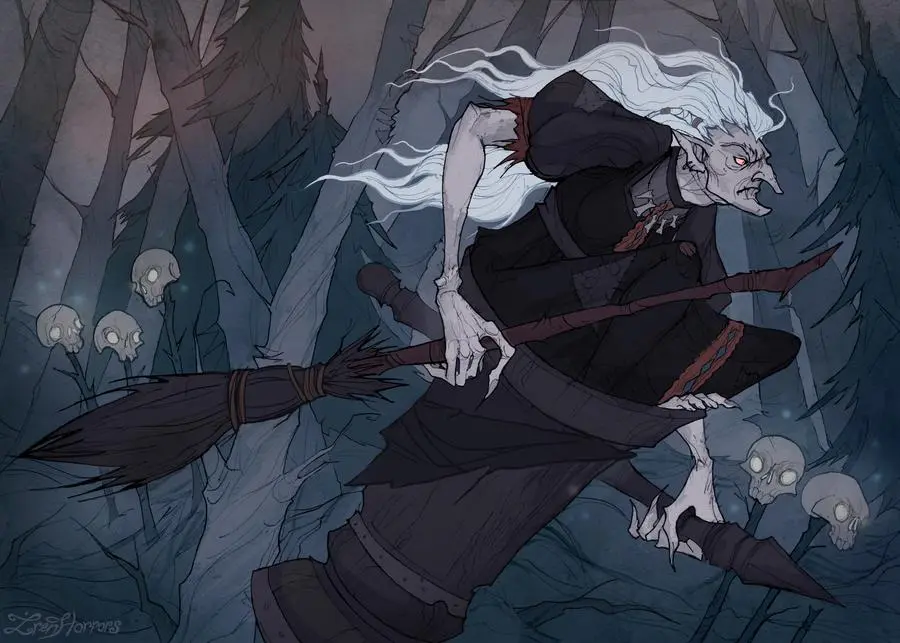Baba Yaga
TricksterThe infamous witch of Slavic folklore who lives in a hut on chicken legs and flies in a mortar wielding a pestle.

Origins & Mythology
Baba Yaga is one of the most iconic figures in Slavic mythology, with origins dating back to pre-Christian Slavic paganism. Her name has been the subject of much scholarly debate. "Baba" means "old woman" or "grandmother" in many Slavic languages, while "Yaga" may derive from various roots meaning "horror," "witch," or "serpent."
Historians believe Baba Yaga may have evolved from ancient Slavic goddess figures associated with death and rebirth. Some scholars connect her to Mokosh, an ancient Slavic goddess of fertility and the earth. Others suggest she represents a personification of winter and death in the seasonal cycle. The transformation of pre-Christian deities into ambiguous or malevolent figures following Christianization was common across Europe.
The earliest written accounts of Baba Yaga appear in Russian fairy tales collected in the 18th and 19th centuries, though oral traditions about her character likely existed for centuries before. Alexander Afanasyev's collection "Russian Fairy Tales" (1855-1863) contains several tales featuring Baba Yaga, helping to standardize her character in literature.
Characteristics & Abilities
Baba Yaga is typically depicted as a hideous, bony-legged old woman with a long, hooked nose, iron teeth, and a disheveled appearance. Her most distinctive features include:
- Her Hut: Baba Yaga lives in a hut that stands on giant chicken legs, allowing it to move and turn around. The hut is often surrounded by a fence made of human bones topped with skulls whose eye sockets glow in the dark. The hut can rotate to face away from visitors, and only turns to face them when specific magical words are spoken.
- Transportation: She flies through the forest in a mortar (a bowl-shaped vessel used for grinding), steering with a pestle, and sweeping away her tracks with a broom made of silver birch.
- Servants: Baba Yaga is served by invisible hands and has three horsemen as her servants: the White Horseman (representing Day), the Red Horseman (representing the Sun), and the Black Horseman (representing Night).
- Powers: She possesses immense magical knowledge and power, including the ability to control the elements, transform herself and others, see far distances, and command forest creatures. She is often portrayed as having knowledge of the water of life and death.
Unlike purely evil witches in Western fairy tales, Baba Yaga is morally ambiguous. She can be helpful or harmful depending on how she is approached and whether proper respect is shown. She often tests those who come to her, setting seemingly impossible tasks that, if completed correctly, earn her assistance.
Gallery

Baba Yaga's hut on chicken legs, surrounded by a fence of human bones topped with glowing skulls

Image by IrenHorrors on Deviant Art

Ivan Bilibin's famous illustration of Baba Yaga from 1900, showing her hunched over in her mortar

Concept art page featuring a set of imaginative designs for magical huts on chicken legs, each with unique shapes and whimsical features
Cultural Impact
Baba Yaga has had an enormous impact on Slavic culture and beyond:
Literature: Beyond traditional folktales, Baba Yaga appears in works by Alexander Pushkin, Nikolai Gogol, and many modern authors. She has inspired countless children's books, novels, and poetry collections.
Visual Arts: Russian artists like Ivan Bilibin and Viktor Vasnetsov created iconic images of Baba Yaga that defined her visual appearance for generations. Her distinctive hut and mortar-and-pestle transportation have become instantly recognizable symbols in Slavic art.
Music and Performance: Modest Mussorgsky's "Pictures at an Exhibition" includes a movement titled "The Hut on Fowl's Legs (Baba Yaga)." Numerous ballets, operas, and theatrical productions feature her character.
Modern Media: Baba Yaga has appeared in countless films, television shows, video games, and comics. Notable appearances include the Hellboy comics, the John Wick films (where she is referenced as a metaphor), and many fantasy games. The 2020 VR experience "Baba Yaga" by Baobab Studios featured the voices of Kate Winslet, Jennifer Hudson, and Glenn Close.
Psychology: Jungian analysts have interpreted Baba Yaga as representing the "terrible mother" archetype or as a symbol of transformation and initiation. Her tests and trials are seen as metaphors for psychological growth.
Today, Baba Yaga continues to fascinate audiences worldwide as a complex figure who defies simple categorization as hero or villain. Her enduring appeal lies in her ambiguity and the way she represents both the dangers and wisdom of the natural world.
Related Characters
- Vasilisa the Wise — Encounters Baba Yaga in 'Vasilisa the Beautiful' and completes her tasks to receive fire
- Ivan Tsarevich — Seeks Baba Yaga's help in several tales, including his quest to defeat Koschei
- Koschei the Deathless — Sometimes portrayed as Baba Yaga's relative or adversary
Tales featuring Baba Yaga

Vasilisa the Beautiful
A tale of a young girl who, with the help of a magical doll, survives the trials of Baba Yaga and becomes a queen.

Marya Morevna
The tale of a warrior princess and her husband Ivan who battles Koschei the Deathless.

The Magic Swan-Geese
A tale of a girl who must rescue her baby brother from Baba Yaga's swan-geese.
References & Further Reading
- Afanasyev, Alexander. Russian Fairy Tales. Pantheon Books, 1973.
- Johns, Andreas. Baba Yaga: The Ambiguous Mother and Witch of the Russian Folktale. Peter Lang, 2004.
- Ivanits, Linda J. Russian Folk Belief. M.E. Sharpe, 1989.
- Forrester, Sibelan. Baba Yaga: The Wild Witch of the East in Russian Fairy Tales. University Press of Mississippi, 2013.
- Hubbs, Joanna. Mother Russia: The Feminine Myth in Russian Culture. Indiana University Press, 1993.